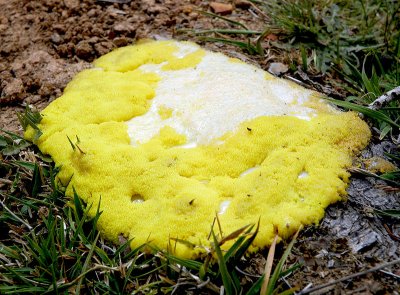About a month ago, I wrote about an interesting study on slime molds.

(Image from KeresH at http://en.wikipedia.org/wiki/File:Dog_vomit_slime_mold.jpg)
Even though they have no brain or other kind of “central processing unit,” they can figure out what the most nutritious food is for them, and they can adjust their shape and eating habits to make sure they get as much nutrition as possible.
These results surprised many scientists, because slime molds are supposed to be primitive creatures.
Indeed, according to the University of Arizona:
Slime molds are primitive fungi that exist chiefly as amoeba-like masses…
Purdue University says
Several species of primitive fungi that can grow and multiply on plant surfaces cause slime molds.
The University of Illinois says:
Slime molds are primitive organisms that lack cell walls and flow or move like amoebae over low lying objects and vegetation…
Why do all these organizations call slime molds primitive? Because that’s what the hypothesis of evolution says. As Dr. James Cavender, a professor of environmental and plant biology at Ohio University, says:
They are extremely old organisms that evolved before plants and animals…
Of course, like most data, actual studies of slime molds show that the evolutionary view of them is far from accurate. The latest study demonstrating that slime molds are anything but primitive was reported in the February 13th issue of Science News. In this study, scientists allowed a slime mold to grow over a set of oat flakes that had been laid out in a pattern that was similar to how major population centers are scattered throughout Tokyo.
Now…when a slime mold is exposed to several food sources that are scattered about, it grows over the food sources and then forms tunnels that distribute the food throughout the entire organism. This, of course, is what the slime mold in the experiment did. After about a day, it had formed a network of interconnecting tunnels that looked very similar to the network of the Tokyo rail system!
Now the Tokyo rail system was not built haphazardly. Engineers struggled to design the most efficient system for ferrying people from one population center to another. They worked long and hard and used several mathematical models to determine how to build the tunnels of the rail system so as to accomplish this goal. The slime mold did the same thing, in a lot less time!
The scientists were so impressed with the fact that the slime mold was able to design such an efficient transport system so quickly that they built a computer program mimicking what the slime mold did in order to produce its incredibly efficient network. As the Science News article says:
A new model based on the simple rules of the slime mold’s behavior may lead to the design of more efficient, adaptable networks…
So this supposedly primitive organism may very well “school” human engineers on how to design networks efficiently. Oh…and if there is any doubt about what this study says about the supposedly primitive nature of slime molds, the title of the Science News article says it all:
Slime Mold as Master Engineer

Looking at the diagrams in your link the networks, though similar, did have very noticible differences, almost significant enough to undermine the conclusions. I’m trying to figure out why that would be. I’m guessing it’s one of five:
the spots of food didn’t adequately take account of the variety of commution levels between cities (e.g. routes to Tokyo have more people but roughly the same food traffic)
Food doesn’t get impatient as easily as passengers. So speed or directness were comparatively less important than the resources spent on growing the tunnels.
The continual flow of food differed from the batch transport used in trains, making a possible route hub more important than a high density source of food (see 1)
The slime moulds weren’t perfectly efficient.
The engineers weren’t perfectly efficient.
What do you reckon?
Josiah, I think the second figure (the one captioned “separated at birth”) is the best one to look at. While the networks are not identical, they are remarkably similar. However, there are differences, and I think those differences are probably a result of two things:
1. Later additions. If you look near the bottom of the rail system diagram, you see three dots on the left and then two dots to the right of them. Those two dots are connected to another dot by a curved tunnel that crosses an existing tunnel. To me, that looks like a later addition to the rail system. If I were designing the rail system with those two population centers in mind, the slime mold’s network is clearly more efficient.
2. The batch transport issue you mentioned in your first comment. Batched flow is different from continuous flow, so you would expect slightly different networks for each.
woops, 6: the petri dishes didn’t have any mountains, rivers, townships, or other little inconveniences for the mould to deal with.
I’ll stop calling them primitive when they can actually build a subway system, not just look like a simple map of one.
Why do so many of your post hinge on exploiting a word’s definition?
Shooter, you’ll never stop calling them primitive, because you don’t want to accept what the data say.
I am not “exploiting” a word’s definition. I am showing how absurd evolutionary thinking is. These organisms are ANYTHING but primitive.